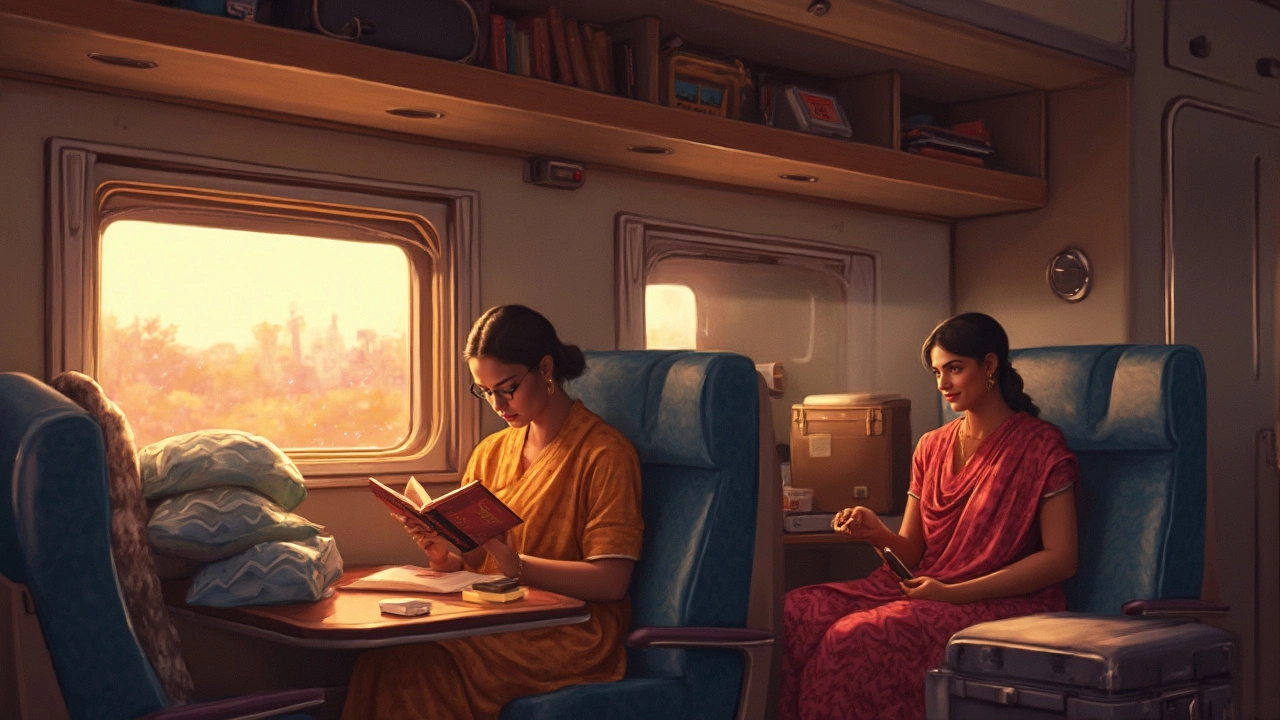SEARCH
Can Two People Comfortably Sleep in an Amtrak Roomette? Pros, Limitations, and Real Experiences


Think squeezing into a phone booth is rough? Try sharing an Amtrak roomette with your partner or best friend for 36 hours straight. You’ll find yourself strategizing over suitcase placement, battling for elbow room, and possibly waking up with someone’s knee half on your pillow. Still, there’s something weirdly charming about it. Roomettes are a staple of classic American rail travel, promising privacy, panoramic views, and a slice of railroad nostalgia. But do they actually work for two people who want a proper night’s sleep without feeling like stowaways in a luggage rack?
The Realities of Sleeping in an Amtrak Roomette
Let’s talk brass tacks: Amtrak’s roomette is a clever little compartment built for two. "Little" is the important word here—think 3’6” by 6’6” of living space, according to Amtrak’s official info. Daytime, you get two plush seats facing each other and a big window. When night falls, your car attendant converts those seats into a lower bunk and unfolds an upper bunk from overhead. This is where things get interesting—and occasionally awkward.
The lower bed measures about 2’4” wide and 6’6” long. It’s slightly wider than a twin, but definitely not full-blown queen mattress territory. The upper bunk is roughly the same width, with a safety net so you don’t tumble out at 2 a.m. Dual sleepers, especially if both are tall or broad-shouldered, might find themselves hip-to-hip, shoulder-to-wall, and playing a nightly round of "whose foot did I just kick?"
Privacy isn’t total—you get a door, but it’s not soundproof, and the sliding lock is more symbolic than secure. There’s a fold-down table, a shallow closet, electric outlets (one or two), and those huge train windows perfect for gazing at prairies and rivers flying by. Storage? Tricky. It’s enough for medium duffel bags and backpacks. Forget full-size suitcases—those go in a communal rack down the hall.
But here’s the deal: you get your own space, compared to the chaos of coach class. No overhead snorer, no jostling for bathroom time, and none of the rowdy birthday party crowd you find near the snack car. Shared bathrooms are just steps away, but if you want a private toilet and shower, that’s only in the pricier Bedroom class.
Let’s break it down and do a side-by-side comparison. Here’s a look at the main room configurations Amtrak offers for overnight journeys:
| Room Type | Sleeping Capacity | Private Toilet/Shower | Main Perks |
|---|---|---|---|
| Roomette | 1-2 | No | Best for privacy, affordable sleeper option |
| Bedroom | 2-3 | Yes | More space, private amenities |
| Family Bedroom | 2 adults + 2 kids | No | Great for families, panoramic windows |
| Accessible Bedroom | 2 | Yes | Spacious, ADA-compliant |
Most people can make the roomette work, but if anyone in your party is a restless sleeper or needs lots of space, expect some creative negotiations. Earplugs help. So do eye masks, since the corridor lights can sneak in through the curtains. Don’t expect complete silence or darkness. A 2022 Amtrak survey showed that 65% of travelers found the roomette "cozy," while about 27% admitted they found it "tight for two, but manageable."

What to Expect: Comfort, Space, and Sleeping Tricks
So what’s it actually like for two people to sleep in here? You’ll each get a pillow and a fresh set of sheets (no hospital corners, but they’re clean). Most attendants are pros at making up the beds and can provide extra blankets if you run cold—the air conditioning does not mess around in those cars, even in midsummer.
The lower bunk is easy to access and feels much like a firm twin. Most folks fight (nicely) over who gets it; the upper bunk, meanwhile, needs a ladder and has less headroom—less than two feet, so unless you’re a true minimalist, you might feel turtle-in-a-shell vibes. The lucky sleeper on the bottom gets the window view at sunrise. The upper bunk is strictly for cocooning with your podcasts and maybe a paperback.
Storage is another battleground. Space under the seats fits one or two small bags. Some roomettes have a shelf above the window or hooks for jackets and toiletry bags. Got giant roller luggage? Stash it elsewhere. Amtrak “veterans” swear by packing cubes and soft duffel bags that fit into weird nooks. One trick: roll your clothes instead of folding, and keep your essentials in a tote for grab-and-go access.
Now, the sleeping arrangement. You won’t get much privacy, but you can each duck behind your own curtain (the upper bunk has its own strip of fabric). The beds are stacked bunk style, which can be cozy or claustrophobic, depending on your relationship and patience. Most noise comes from the tracks, the occasional door slam down the corridor, or the muffled “Good morning!” from the attendant during station stops.
What if you toss and turn? Not ideal—the bunks are up against the wall, so night trips to the bathroom mean one person climbs down or shimmies across. The roomette wasn’t designed for synchronized sleep schedules. Pro tip from a San Francisco Times travel writer: “Settle who has the lower bunk before boarding. Trust me, you don’t want to negotiate at midnight while half-asleep.”
If you’re light sleepers, bring earplugs—train tracks are not subtle, and the engine rumbles are louder up front. Window shades keep the worst light out, but some cracks remain. Eye masks are worth their weight in gold.
Here’s a practical packing list for two passengers sharing a roomette:
- Soft, collapsible luggage
- Headphones or earplugs
- Eye mask
- Refillable water bottle
- Travel-size toiletries (showers are at the end of the car, not in the roomette)
- Change of clothes and slippers
- Chargers for phones, maybe a power strip
- Snacks (meals are included with sleeper tickets, but options are limited after hours)
Meals and coffee are included—another reason some folks book sleeper tickets. Don’t expect five-star dining, but hot breakfasts, dinner entrees, and plenty of coffee arrive via your car attendant. Tip generously—attendants make the whole thing feel a little more first-class, even if you’re eating chili at 60 miles per hour.

Real Passenger Stories and Handy Tips
Does the tight squeeze bother everyone? Not exactly. A cross-country journey is about the scenery and the shared experience, not spa-level comfort. Travelers have loads of opinions—people who’ve logged 48-hour trips from Chicago to Los Angeles or overnight on the Crescent to New Orleans have plenty to say about what works (and what doesn’t).
Sarah, who runs the travel blog RailRose, summed up the trade-offs:
"Sharing a roomette with my boyfriend felt like spending a weekend in a cozy fort—close quarters, yes, but we managed with soft-sided bags, booklights, and a healthy amount of teamwork."If you’re used to solo hotel rooms, you’ll notice the difference. But if you travel light and value experiences over square footage, the roomette feels more like a quirky adventure than a deprivation.
One thing that surprises plenty of first-timers is the constant movement. Sleeping on a train is different from a stationary bed—there’s swaying, gentle rocking, and the rare lurch as cars connect or detach. Some find it relaxing, even sleep-inducing, while others take a night or two to get used to the motion.
Romance is possible, but let’s be honest: there’s not much room for stretching out, and the upper bunk is barely wide enough for one. If both of you are tall, someone’s feet will brush the edge of the wall. If one snores, the other will know within seconds. But most couples laugh it off, swap beds halfway through the night, or take turns napping during the day.
You might wonder about security. There’s a lock on the door, but it only works from the inside while you’re there. When you leave, you close the door but can’t lock it. Most thefts are rare because the sleeper car is a community and most passengers look out for one another. Attendants are always nearby, checking tickets and keeping tabs on who’s supposed to be in each room.
Showering is another talking point. Roomettes don’t have private bathrooms, but each sleeper car has shared showers and multiple restrooms at the end of the hallway. Towels, soap, and washcloths are provided; you just bring your own patience if it’s a peak morning rush. The facilities are cleaner than many roadside motels, regularly serviced by onboard staff.
If you’re a light packer, you’ll love it. If you bring everything on a “just in case” basis, expect to re-think your essentials. A good book, a deck of cards, or a streaming app is essential—Wi-Fi coverage is getting better but notorious for dead zones along the route.
Here’s a tip from frequent Amtrak riders: ask your attendant for an extra blanket or pillow right after boarding. Supply runs out fast, especially on full trains. And don’t feel shy tipping for little extras—most attendants go the extra mile, from coffee refills to second helpings at dinner.
To sum it up: yes, two people can sleep in an Amtrak roomette, and thousands do every week. Is it lavish? Nope. Is it a story you’ll tell for years? Absolutely. That clackety rhythm outside your window, the endless sky rolling past, and the challenge of synchronized suitcase acrobatics make train travel unlike any ordinary hotel night. Embrace the adventure. And maybe—just maybe—flip a coin for the coveted lower bunk before the train leaves the station.